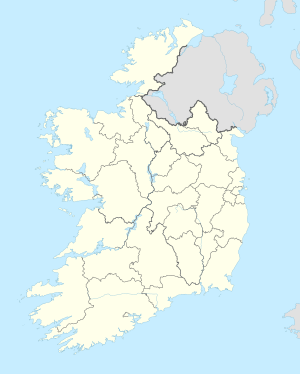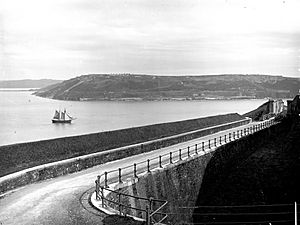Fort Davis, County Cork facts for kids
Quick facts for kids Fort Davis |
|
|---|---|
| Dún an Dáibhisigh | |
| Near Whitegate in County Cork in Ireland | |

Fort Davis viewed from Cork Harbour
|
|
| Coordinates | 51°48′58″N 8°15′40″W / 51.816°N 8.261°W |
| Type | Coastal defence fortification |
| Area | 74 acres (30 ha) |
| Site information | |
| Owner | Department of Defence |
| Open to the public |
No |
| Site history | |
| Built | 1607 (original castle) 1860s (significant reconstruction) |
| Events | Siege of Cork (1690), Treaty Port handover (1938) |
| Garrison information | |
| Occupants | British Armed Forces, Irish Defence Forces |
Fort Davis, known in Irish as Dún an Dáibhisigh, is an old coastal fort near Whitegate, County Cork, Ireland. It was built to protect the coast. This fort, along with Fort Mitchel (on Spike Island), Fort Camden (in Crosshaven), and Templebreedy Battery, guarded the entrance to Cork Harbour.
Even though there was a fort here since the early 1600s, most of the buildings you see today were built in the 1860s. It was first called Fort Carlisle and was run by the British Armed Forces. In 1938, the fort was given to the Irish Defence Forces and renamed Fort Davis. Today, the Department of Defence owns the fort. It is used as a military training site and is not open to the public.
Contents
History of Fort Davis
The coastline near Whitegate is a very important spot. It looks over the entrance to Cork Harbour. This harbor is one of the biggest natural harbors in the world. It has always been important for defending Ireland.
Early Fortifications
One of the first forts here was built before 1607. It was called "Prince Rupert's Tower." Later, during a war in the late 1600s, more defenses were added. This new fort was known as "King John's Fort." Both this fort and Fort Camden were captured during the Siege of Cork in 1690.
More building work happened in the late 1700s. Some tunnels and buildings from this time were used to hold French prisoners during the Napoleonic Wars (1803–1815).
Victorian Era Changes
By the mid-1800s, the fort was renamed Fort Carlisle. In the 1850s, a special group looked at how important Cork Harbour was. They suggested making the defenses stronger at Fort Mitchel, Fort Camden, and Fort Carlisle.
So, in the 1860s, Fort Carlisle was rebuilt. It became like other "Palmerston Forts" in the area. These new parts used concrete, which was a modern building material at the time.
World Wars and Handover
During the First World War (1914–1918), Cork Harbour was a naval base. Fort Davis helped protect the harbor entrance. Soldiers from the Royal Garrison Artillery Coastal Defence were stationed there.
The fort did not see much fighting during the Irish War of Independence. After this war, the British government kept control of the harbor defenses. These places, called Treaty Ports, included Fort Carlisle.
In 1938, Fort Carlisle was given to the Irish authorities. It was renamed Fort Davis after Thomas Davis, a leader of the Young Ireland movement. Other forts were also renamed at this time.
During "the Emergency" (1939–1945), which was Ireland's name for World War II, parts of the Irish Artillery Corps operated from the fort. Later, the fort was mainly used for training. Today, the Department of Defence still owns it. The Irish Army uses it for exercises, gun salutes, and other training.
Fort Layout
Most of Fort Davis was built in the 1800s. At its busiest, the fort had more than 20 guns.
Land Defenses
On the side facing the land, the fort had a dry-moat, ramparts, and other defenses. These protected the fort from attacks by land. The dry-moat was about 30 feet (9.1 m) deep and 40 feet (12 m) wide. It used to have a drawbridge to cross it. The land defenses were shaped like a star. They included places for soldiers to fire muskets and areas for movable guns.
Sea Defenses
On the side facing the sea, there were eight gun emplacements. These were built to fire at ships in the harbor. These areas had underground shelters and magazines (places to store ammunition). Tunnels connected some of these areas.
Over time, the guns changed, but the main batteries included:
- Main emplacement – This part was built during the Napoleonic era.
- Number 1 battery – This battery was rebuilt for three QF 12-pounder guns.
- Number 2 battery – This had two large RML 10 inch guns.
- Number 3 battery – This had four RML 7 inch guns.
- Number 4 battery – This had four RML 10 inch guns. It was later used to store oil.
- North Battery – This had two BL 6 inch coastal defense guns.
- Rupert's Tower Battery – This had two large RML 12 inch guns. It was later rebuilt for two BL 6-inch Mk VII guns.
- South Battery – This had two very large BL 9.2 inch guns.
Other parts of the fort include a military cemetery. There is also a pier (a small dock) for boats to reach the fort. Many buildings above ground were used as barracks for soldiers and for other support needs.
In 2015, during some cleaning work, evidence of torpedo defenses was found at the fort.




